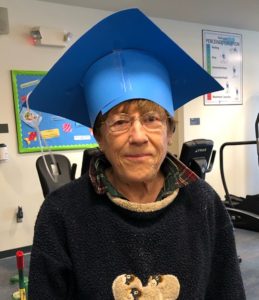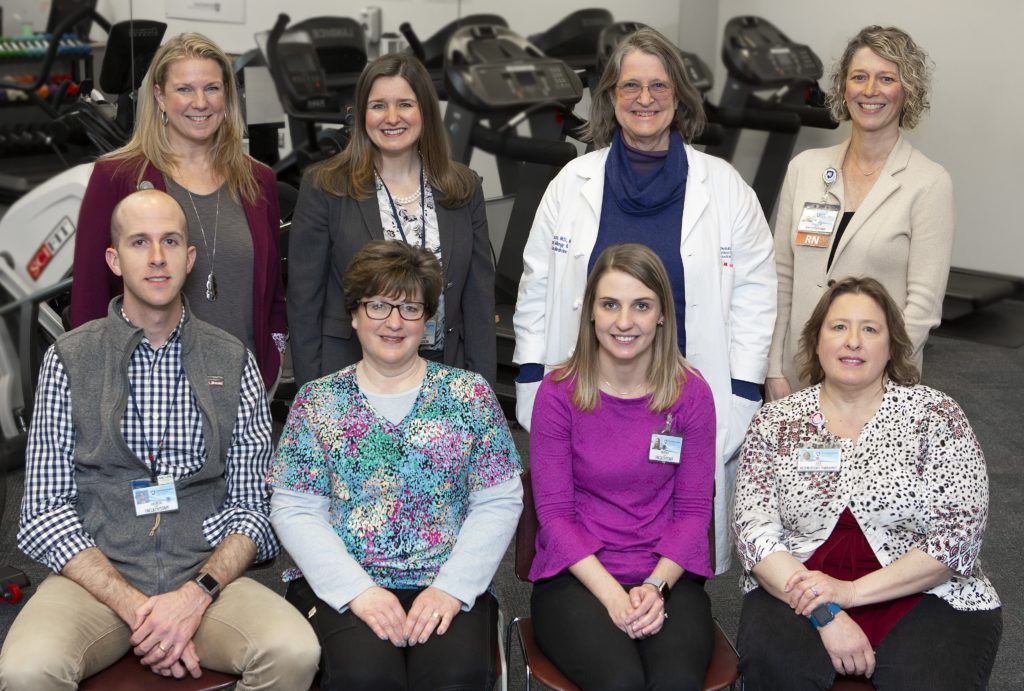Breathing easier: Pulmonary rehab program increases quality of daily life

By Carolyn Kimmel
Freddie Cadmus remembers when walking to her curbside mailbox and back took almost all the breath she had. These days, it’s an easy jaunt for the 69-year-old Swatara Township woman.
That’s thanks to the Pulmonary Rehabilitation Program at Penn State Health Milton S. Hershey Medical Center, where Cadmus spent 10 weeks exercising to increase her physical endurance while learning how to manage her breathing, medications and mental outlook. She is living with chronic obstructive pulmonary disease, or COPD, which has no cure.
“After this program, I realized I’m stronger than I thought I was,” said Cadmus, who was diagnosed about eight years ago. “It’s given me back my confidence.”
With its mix of exercise and education, the program also boosted something that isn’t measurable on outcome tests – her optimism.
Point at the image below to reveal slideshow controls.

“Before, I was really a hermit and afraid to go out very much because I would lose my breath,” Cadmus said. “Now I’m going out more to see friends, and I don’t have to worry that I’ll be out of breath halfway through the grocery store.”
“It’s amazing to see patients so burdened by disease when they come to us, and when they leave, they look like new people,” said Dr. Rebecca Bascom, medical director of the Pulmonary Rehabilitation Program, which has served 25 patients since it opened last summer. “Patients tell us, ‘I still may hit a wall, but I get so much further before I do.”
Located at the Health and Wellness Center on the Milton S. Hershey Medical Center campus, the program is a vital part of comprehensive care for patients dealing with chronic lung disorders such as pulmonary fibrosis, asthma, bronchitis, pulmonary hypertension and COPD, doctors say.
“By increasing patients’ activity in a monitored setting, pulmonary rehabilitation provides a venue for chronic lung disease patients to improve not only their functional status but also their quality of life,” said Dr. Safa Farzin, Penn State Health vice president of medical affairs and staff development and former vice president of Pulmonary Critical Care Medical Associates, which joins Penn State Health on March 1. “This addition to our repertoire of services is a great benefit to the community.”
Whitney Hohn, practice site manager of the pulmonary function lab, says it’s exciting to offer an in-house program for patients who previously may have faced a half-hour drive to a similar program – no small feat for a person already struggling for breath.
“Many times, they just didn’t go,” she said. “We’re seeing great results. Patients tell us they feel better in their day-to-day activities, and they are able to catch their breath more.”

Freddie Cadmus celebrates graduating from the Pulmonary Rehabilitation Program, which improved her stamina and outlook.
Gauging the right amount of exercise is a big challenge that patients learn to navigate, Bascom said. Patients are monitored as they work out on a treadmill, arm bike, recumbent bike and seated elliptical.
Another patient benefit is fewer trips to the emergency department and fewer hospitalizations, said Becky Gingrich, who, in her role as senior director of ambulatory practice site operations, examined clinical benefits in order to move the new program through the health system.
“It definitely improves the overall outcome for the patient, and we’re excited because we’re making a positive impact on people’s lives,” she said.
Andrew Sorey, cardiac rehab manager who offered up his expertise, space, staff and equipment, said the pulmonary rehab program is innovative because it is so personalized.
“Not everybody wants to do the same things or has the same goals,” he said. “By not forcing a canned program on everyone, it makes people more likely to follow through with their treatment plan, and they have better outcomes.”
Penn State Health St. Joseph Pulmonary Rehabilitation Program, the first of its kind in Berks County, served as a model for the program at Hershey Medical Center.
“We see patients who come in and can only walk 800 to 900 feet,” said Lilly Morales, pulmonary rehab lead at St. Joseph. “We look for improvement of at least 98 feet, and we see 200 to 300 feet. They also report they are less depressed and feel like they’re not alone.”
Pulmonary rehabilitation programs are relatively new compared to other rehab services such as physical therapy and can be subject to restrictive insurance coverage, however, Morales said, “You can’t put a price on the benefits.”
That said, as with any chronic condition that requires adherence to prescribed medicine, patients must continue to stay active, or progress will decrease, she said.
“What is wonderful about pulmonary rehab is that it gives people the tools and skills to write their own ‘exercise is medicine’ prescription that they can continue for the rest of their lives,” Bascom said. “And the out-of-pocket cost is often much less than medications.”
Cadmus, who admits she needs to be more disciplined in following her exercise regimen, plans to redo the program, this time on her own dime. It’s well worth it, she said.
“My thanks to Whitney – she’s on my case, and I need that push,” Cadmus said. “I have no cure, but I have optimism – and that means a lot.”

Top row, from left, Heather Fanus, outpatient services director, Penn State Health Medical Group; Deborah Berini, president, Hershey Medical Center; Dr. Rebecca Bascom, Pulmonary Rehabilitation Program medical director; and Becky Gingrich, senior director of ambulatory practice site operations. Bottom row, from left, Andrew Sorey, cardiac rehab manager, and respiratory therapists Joanne Winters, Whitney Hohn and Julie Chudnofsky.
If you're having trouble accessing this content, or would like it in another format, please email Penn State Health Marketing & Communications.
